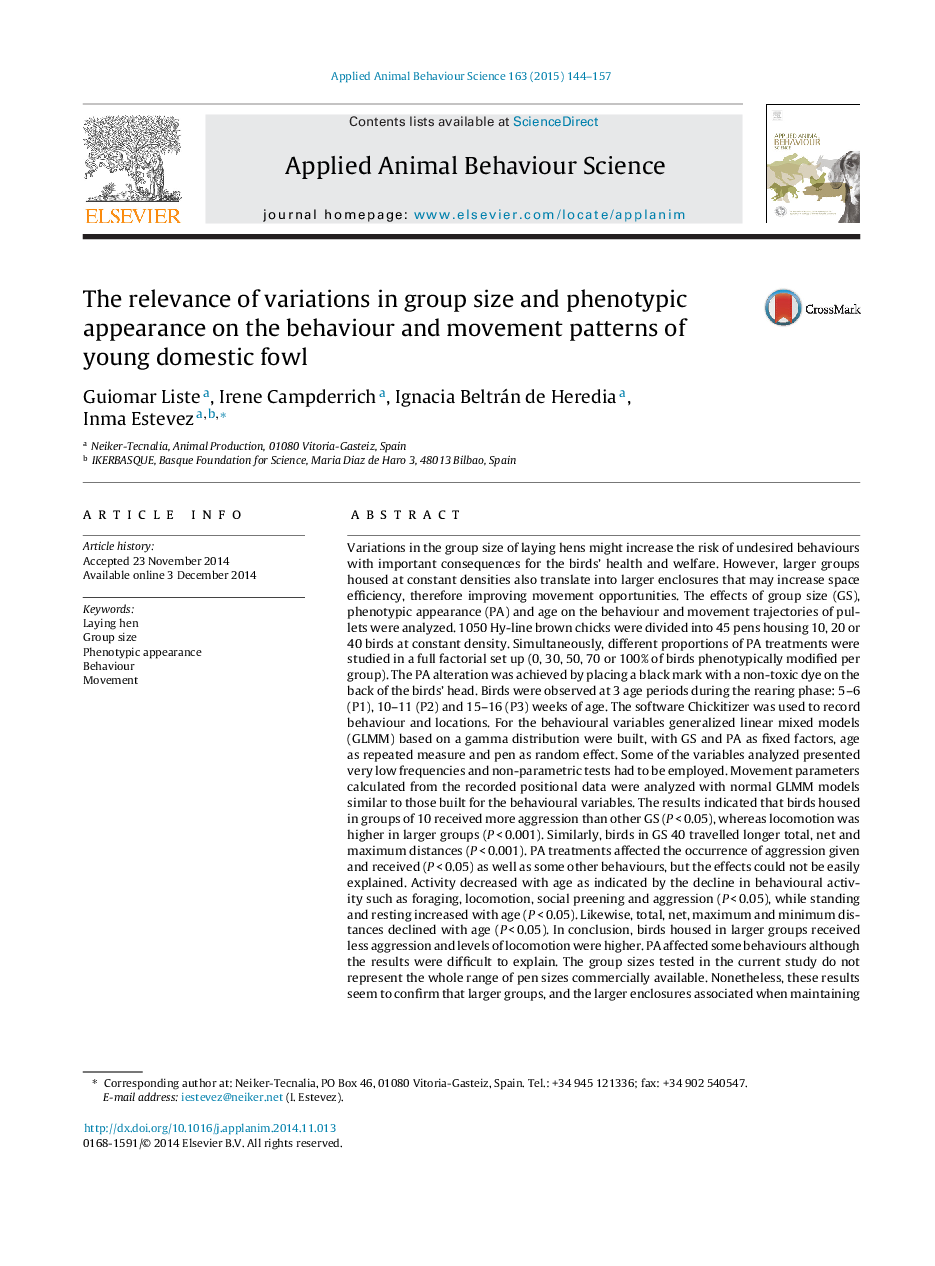| کد مقاله | کد نشریه | سال انتشار | مقاله انگلیسی | نسخه تمام متن |
|---|---|---|---|---|
| 6379627 | 1625343 | 2015 | 14 صفحه PDF | دانلود رایگان |
عنوان انگلیسی مقاله ISI
The relevance of variations in group size and phenotypic appearance on the behaviour and movement patterns of young domestic fowl
ترجمه فارسی عنوان
ارتباط تغییرات در اندازه گروه و ظاهر فنوتیپی بر رفتار و الگوهای حرکتی مرغ جوان
دانلود مقاله + سفارش ترجمه
دانلود مقاله ISI انگلیسی
رایگان برای ایرانیان
کلمات کلیدی
تخم مرغ، اندازه گروه، ظاهر فنوتیپ، رفتار - اخلاق، جنبش،
موضوعات مرتبط
علوم زیستی و بیوفناوری
علوم کشاورزی و بیولوژیک
علوم دامی و جانورشناسی
چکیده انگلیسی
Variations in the group size of laying hens might increase the risk of undesired behaviours with important consequences for the birds' health and welfare. However, larger groups housed at constant densities also translate into larger enclosures that may increase space efficiency, therefore improving movement opportunities. The effects of group size (GS), phenotypic appearance (PA) and age on the behaviour and movement trajectories of pullets were analyzed. 1050 Hy-line brown chicks were divided into 45 pens housing 10, 20 or 40 birds at constant density. Simultaneously, different proportions of PA treatments were studied in a full factorial set up (0, 30, 50, 70 or 100% of birds phenotypically modified per group). The PA alteration was achieved by placing a black mark with a non-toxic dye on the back of the birds' head. Birds were observed at 3 age periods during the rearing phase: 5-6 (P1), 10-11 (P2) and 15-16 (P3) weeks of age. The software Chickitizer was used to record behaviour and locations. For the behavioural variables generalized linear mixed models (GLMM) based on a gamma distribution were built, with GS and PA as fixed factors, age as repeated measure and pen as random effect. Some of the variables analyzed presented very low frequencies and non-parametric tests had to be employed. Movement parameters calculated from the recorded positional data were analyzed with normal GLMM models similar to those built for the behavioural variables. The results indicated that birds housed in groups of 10 received more aggression than other GS (PÂ <Â 0.05), whereas locomotion was higher in larger groups (PÂ <Â 0.001). Similarly, birds in GS 40 travelled longer total, net and maximum distances (PÂ <Â 0.001). PA treatments affected the occurrence of aggression given and received (PÂ <Â 0.05) as well as some other behaviours, but the effects could not be easily explained. Activity decreased with age as indicated by the decline in behavioural activity such as foraging, locomotion, social preening and aggression (PÂ <Â 0.05), while standing and resting increased with age (PÂ <Â 0.05). Likewise, total, net, maximum and minimum distances declined with age (PÂ <Â 0.05). In conclusion, birds housed in larger groups received less aggression and levels of locomotion were higher. PA affected some behaviours although the results were difficult to explain. The group sizes tested in the current study do not represent the whole range of pen sizes commercially available. Nonetheless, these results seem to confirm that larger groups, and the larger enclosures associated when maintaining constant densities, could be beneficial for the welfare of pullets. However, these effects could be age dependent as trajectories shortened with age which could be explained by the larger size and general decline in activity observed in older birds.
ناشر
Database: Elsevier - ScienceDirect (ساینس دایرکت)
Journal: Applied Animal Behaviour Science - Volume 163, February 2015, Pages 144-157
Journal: Applied Animal Behaviour Science - Volume 163, February 2015, Pages 144-157
نویسندگان
Guiomar Liste, Irene Campderrich, Ignacia Beltrán de Heredia, Inma Estevez,
